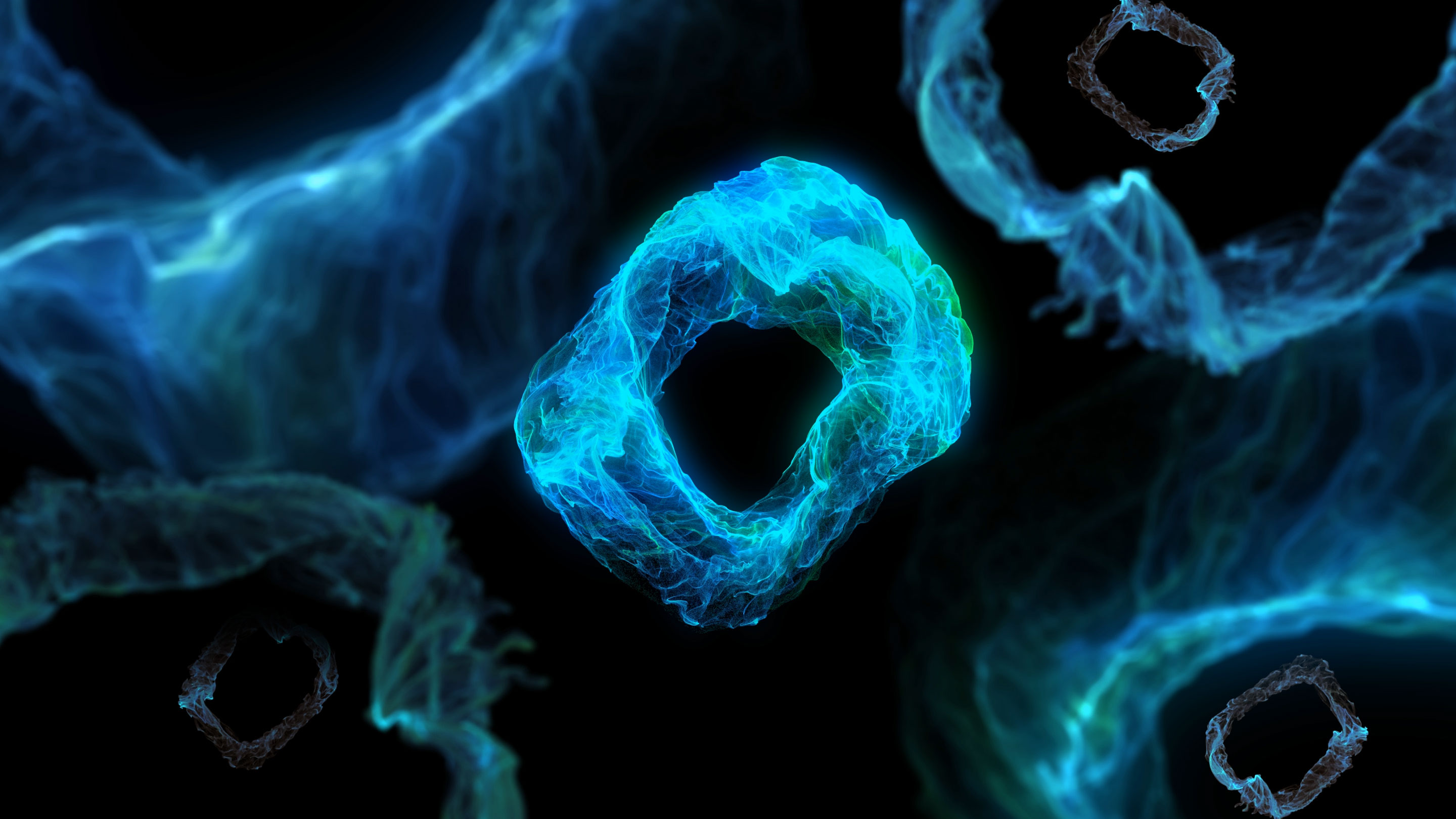An Unexpected Twist Lights Up the Secrets of Turbulence
Introduction
It’s time to feed the blob. Seething and voracious, it absorbs eight dinner-plate-size helpings every few seconds.
The blob is a cloud of turbulence in a large water tank in the lab of the University of Chicago physicist William Irvine. Unlike every other instance of turbulence that has ever been observed on Earth, Irvine’s blob isn’t a messy patch in a flowing stream of liquid, gas or plasma, or up against a wall. Rather, the blob is self-contained, a roiling, lumpy sphere that leaves the water around it mostly still. To create it and sustain it, Irvine and his graduate student Takumi Matsuzawa must repeatedly shoot “vortex loops” — essentially the water version of smoke rings — at it, eight loops at a time. “We’re building turbulence ring by ring,” said Matsuzawa.
Irvine and Matsuzawa tightly control the loops that are the blob’s building blocks and study the resulting confined turbulence up close and at length. The blob could yield insights into turbulence that physicists have been chasing for two centuries — in a quest that led Richard Feynman to call turbulence the most important unsolved problem in classical physics. (Quantum turbulence has become an important problem too.) Untangling turbulence might also prove extraordinarily impactful, given that it plays a huge role in stars, aviation, nuclear fusion, weather, changes in the Earth’s core, wind turbines and even human health — arterial flow can become dangerously turbulent.
If the blob does yield big advances in turbulence, it will add to the growing string of surprising and influential breakthroughs that Irvine and his students have produced in the physics of what might loosely be called spinning stuff — systems composed of whirling objects, fluids and even fields.
Especially attention-grabbing among Irvine’s findings has been the lab’s contribution to fluid dynamics, an area that has been notorious for painfully slow progress, in part because of the difficulty of collecting good data. The most prominent breakthrough involves proving a fundamental new law governing the tornado-like tubes of currents known as vortices. The law illuminates how these fundamental phenomena form, interact, evolve and decay. “Science often involves finding a way to tweak or fill a small gap in what’s been done,” said Daniel Lathrop, a University of Maryland physicist specializing in nonlinear dynamics who is familiar with Irvine’s work. “William asks what he can do that’s completely different than what’s been done. It’s the sort of work that can open new fields.”
But now that his mastery of vortices has led him to the blob, Irvine senses even bigger — and more dangerous — prey in the water. “Because of the absence of good data and theory, turbulence has been considered the place where careers go to die,” said Irvine. “I find myself getting more and more into it.”
A New Twist
By 2006, at the age of 26, the Italian-born Irvine had already made his way through two separate doctorates in quantum optics, one in experimental physics at the University of Oxford and the other in experiment and theory at the University of California, Santa Barbara. He then decided he’d had enough of eking out small advances in esoteric areas of physics, and he got ready to begin a postdoc at Princeton University in the more wide-open field of neuroscience. But then a friend happened to mention the work that the New York University physicist Paul Chaikin was doing with “soft matter” such as foams, colloids, gels, liquid crystals and other less typical types of nonsolid matter.
Chaikin and others in the nascent field were getting materials to exhibit properties that had never been seen before, such as self-replication and self-assembly — and unlike conventional condensed matter physicists, they were working with their materials at room temperature in beakers right before their eyes, instead of in refrigerators near absolute zero. Even more important, from Irvine’s point of view, they were making big leaps into mostly unexplored territory. “It’s a field where people can still make fundamental discoveries,” he said. “It’s where you build experiments not to confirm the answer, but because no one knows what the answer is.”
Irvine jumped into Chaikin’s lab as a postdoc, working on colloids, or particles suspended in liquid. But one day, during a walk in downtown Manhattan, Irvine noticed someone blowing smoke rings, and he immediately rushed back to the lab to try to build a contraption that could produce more complex structures out of smoke. He didn’t get far and put the project aside. But he didn’t forget about those rings, and when he joined the faculty at the University of Chicago, he started working on vortex loops in water, undeterred — indeed, energized — by knowing nothing about the subject. “I’d never even taken a course in fluid mechanics,” he admitted. “I learned it here when I had to teach it.”
What he learned was that a vortex is basically a tubelike twisting current in a gas, liquid or other medium, a tornado being the most familiar example. Vortices can be remarkably stable, and yet they are also surprisingly mutable. As in a smoke ring, their ends can be connected to form a loop, and multiple vortex loops can be linked, merged and even knotted. (Dolphins can outdo smokers in this regard, blowing vortex loops apparently just for fun.)
One reason physicists want to know more about the properties of vortices is that vortices routinely pop up in all kinds of particle fields, including electric and magnetic fields. A simple example: A current coursing through a wire creates a magnetic-field vortex around the wire — a sort of tornado of magnetism that would cause a hypothetical magnetic particle near the wire to circle the wire, just as a tiny volume of water would be carried around a whirlpool. (The magnetic particle is hypothetical, because such “monopoles” don’t seem to exist in nature.)
One of Irvine’s early breakthroughs, with then graduate student Hridesh Kedia, was to show how light fields can be tied into knots. But Irvine was particularly interested in water. Making a tornado-like vortex in water is easy — anyone can do it with a soda bottle. But how to make loops and more complex shapes and combinations of vortices, including knots? Doing so would be crucial to settling long-standing questions about a fundamental property of vortices called helicity. Vortex helicity has long been defined as the total number of links and knots in a vortex or in a connected group of vortices. Links and knots are topological characteristics, in that they don’t change when vortices are stretched, compressed or otherwise deformed.
For half a century it’s been known that vortex helicity is conserved in an ideal fluid — basically, a fluid that has no viscosity, meaning it offers no resistance to an object pushing through it. If such a fluid existed, then no matter what changes a vortex or group of linked vortices in the fluid went through, the number of links and knots would add up to the same number.
The question of whether some form of that law might apply to real-world fluids and gases remained stubbornly resistant to all analysis and experiment. Yet such a conservation law would be immensely useful to meteorologists and others who deal with vortices — that same wide spectrum of researchers who deal with turbulence.
The search for insight into helicity conservation was tied to another fundamental question: Where does the “twistiness” in vortices go when they eventually decay, as they always do? Rotational energy and momentum must be conserved, but it wasn’t clear how the macro whirling of a vortex is transferred to smaller and smaller scales, ultimately dissipating at the molecular level. Understanding that mechanism would likely shed light on helicity conservation, and vice versa.
To come up with an experimental platform that might provide some answers, Irvine drew on one of his hobbies. He has an immensely rich vein to mine there: He speaks four languages, plays a mean cello (and has studied three other instruments), is a moderately accomplished rock climber, sails, and is a commercially rated airplane pilot who flies aerobatics for fun. (“If you do something really good in science,” he explained, “it’s probably because you were careful to take time out to play.”) It was this last pastime that primed him to come up with an idea for producing water vortices. Pilots are well aware that fierce vortices form at the wingtips of accelerating planes and separate from there. Why not try to make them in water with a winglike shape, or hydrofoil?
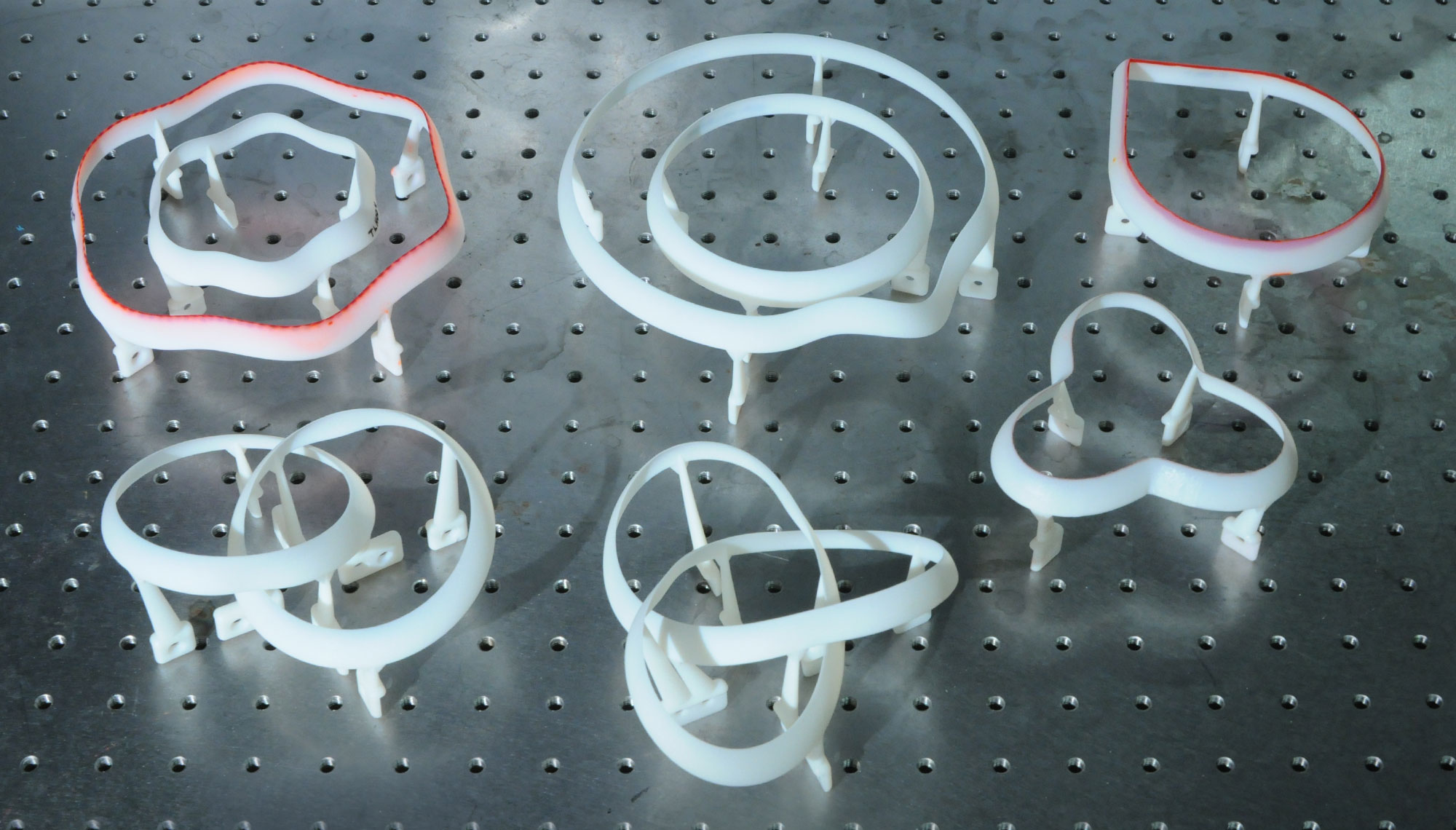
A selection of Irvine’s custom-designed hydrofoils.
William Irvine
Enlisting a 3D printer capable of producing a new hydrofoil of arbitrary shape in eight hours, Irvine tried out hundreds of shapes with his postdoc at the time, Dustin Kleckner, and later with his graduate students Martin Scheeler and Robert Morton. To find a way to accelerate the hydrofoils at the equivalent of 100 times the force of gravity, the researchers explored everything from explosives to rail guns, finally landing on what Irvine calls the “potato gun” — a powerful piston driven by compressed gas. To accommodate this and other Wile E. Coyote-looking contraptions, along with a giant water tank, Irvine had taken over a large space three floors below ground in a lab building, knocking out a 14-foot ceiling and all the building innards above it to get a 30-foot-tall space into which he could fit a small crane.
Finally the hydrofoils started producing neat rings up to about a foot wide. They even created linked rings and knotted vortices. Kleckner and Scheeler surrounded the water tank with high-speed laser-scanning tomography and video cameras. Tiny gas bubbles and tracer particles were shot into the tank so they could get caught up in the swirling currents, allowing the researchers to see and closely measure the evolution of the vortices. Then they had a lucky break: They took to writing on the hydrofoils with a Sharpie to help identify them, but the ink bled into the water and got caught up in the vortices, where it fluoresced in the laser light and offered up an image even clearer than the ones provided by the bubbles. By purposely drawing dashes of Sharpie ink — and later their own specially formulated ink — in the right places on the hydrofoils, the researchers found they could highlight any segments or features of the resulting vortices, such as a vortex’s center line, which was otherwise hard to identify.
By 2017, the effort to create an experimental underwater vortex circus had paid off with proof of what happens to helicity in the real world. As it turns out, real-world vortices do not behave like ideal fluids: The number of links and knots in the vortices isn’t always conserved as the vortices evolve. But Irvine threw two new factors into the mix: “writhing” and “twisting.” Imagine a straight length of hose, representing the length of a straight vortex like a tornado. Writhing reflects the hose taking on a wriggly shape, like that of a Slinky, or in a more extreme case becoming coiled. Twisting means the ends of the hose are twisted in opposite directions, even while the hose remains straight. Writhing and twisting aren’t topological features, strictly speaking, but they are “geometric” features, the essential difference being that geometric features can be confined to a particular section of an entity, whereas topological features are global properties.
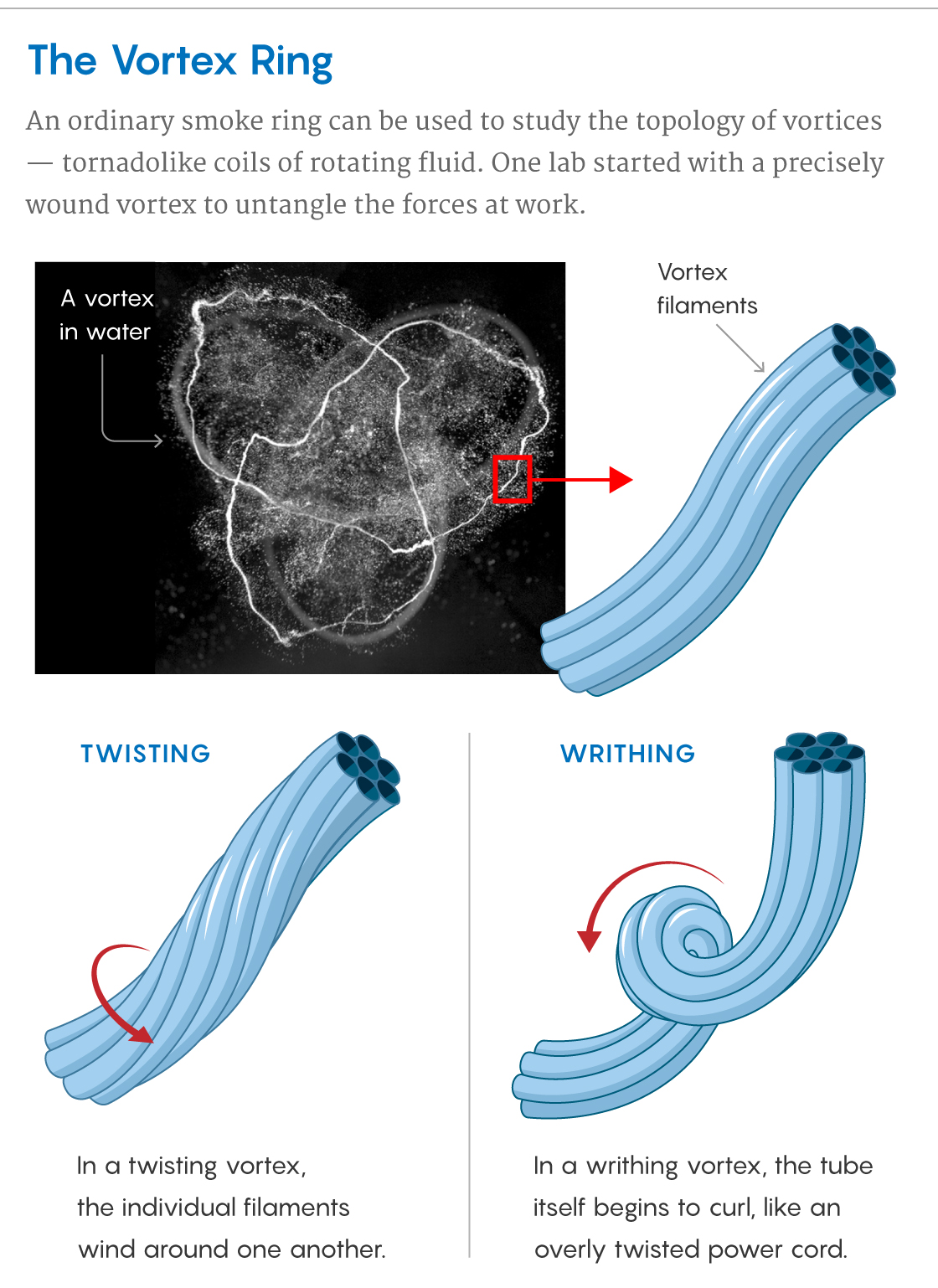
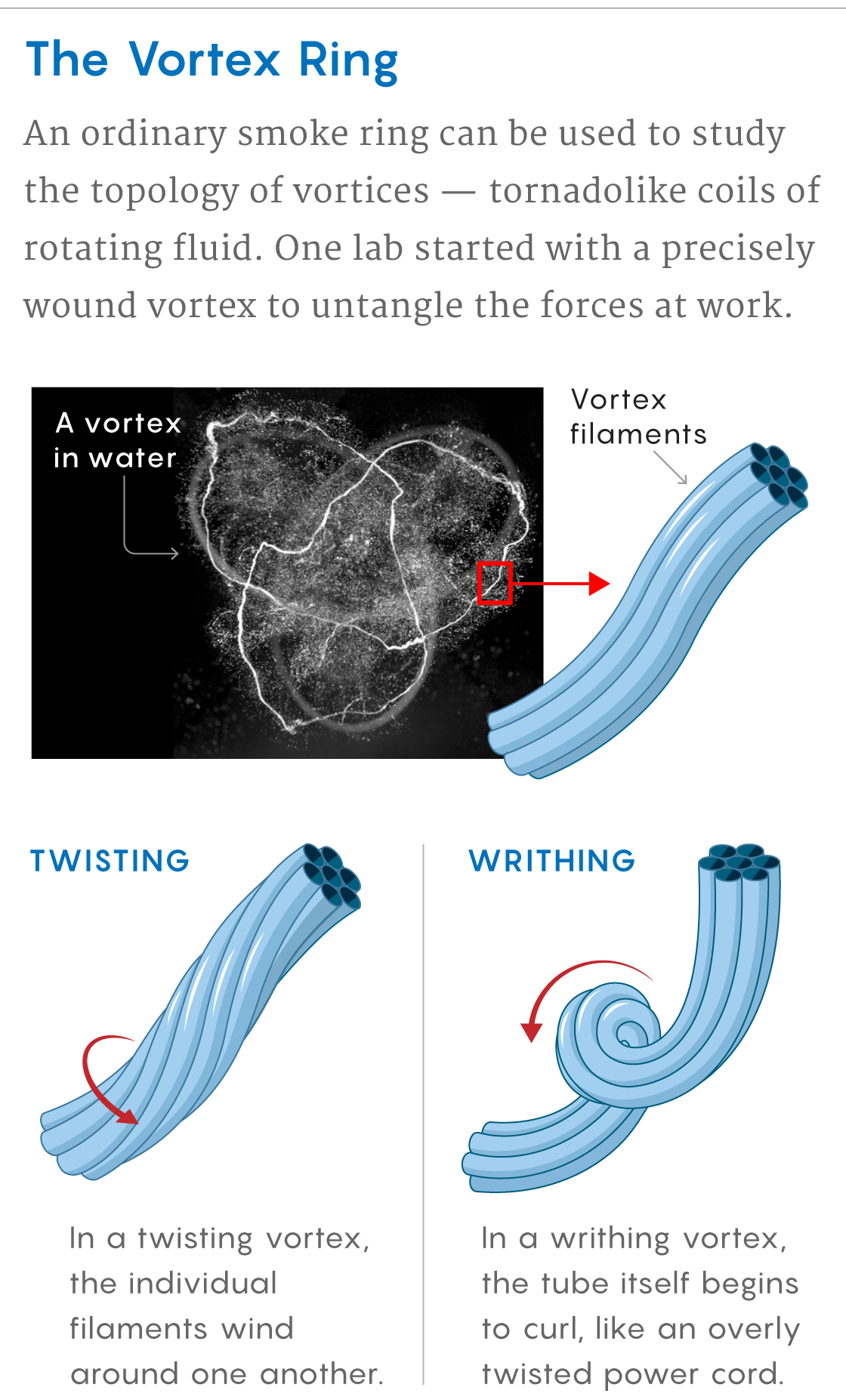
Samuel Velasco/Quanta Magazine;
source: doi: 10.1126/science.aam6897 / Irvine Lab
Other researchers had previously suggested that including these geometric characteristics along with links and knots might provide a more general measure of the complexity and “twistiness” of a vortex — one that might even lead to a new conservation law. Irvine pinned down that new law and proved it. He showed that the knots, links and writhing — ignoring the twisting — don’t lose their combined helicity to viscosity. But the writhing can be converted to twisting — just as a coiled hose can be pulled straight, causing extensive twisting in the hose. What’s more, the vortex can untwist itself, twisting the viscous medium around it as it does so. In that way, the vortex essentially loses its twist — and its helicity along with it — to the surrounding medium. “Because of the geometry, it actually evolves quite smoothly,” said Irvine.
The work, published in 2017 in Science, not only offered a fuller accounting of how helicity evolves in the real world, it suggested how the vortex loses its spin-related energy and momentum to the environment. “You really have to admire William’s style as an experimentalist,” said Lathrop. “To create such a novel setup and work it to get answers is impressive.”
A Persistent Chaos
In a series of Zoom interviews, Irvine, now 40, presents as friendly and wry. But he’s also pensive and intense, an impression amplified by his wild blob of turbulent hair. His graduate students praise him freely as a scientist and mentor. “He has outlandish ideas that initially don’t seem to make sense, but I always end up learning from them,” said Ephraim Bililign, a current graduate student in the lab. As an example he offers Irvine’s suggestion that he try to coax new behaviors out of soap films — a project that proved unworkable, but which directly led to Bililign’s current work with whirling microscopic magnetic cubes in a soap-film suspension, which exhibit a variety of strange properties.
At the same time, Irvine’s students note that he remains deeply private, almost to the point of being mysterious. They were stunned to find out recently that he has long been a pilot.
The eccentric, improvisational zigzags in his early career, along with the array of challenging hobbies, suggest that Irvine is constantly searching for the proper match for his considerable abilities. Chaikin said he understands why Irvine pushes himself so hard. “William is the best postdoc I’ve ever had,” he said. “Unusually, he’s as facile in doing theory to figure out what experiments need to be done as he is in doing the experiments. He can break things open in different fields.”
Irvine’s wide-ranging interests are reflected in the array of projects going on in his lab these days. In addition to the vortex work, he and his students have been busy exploring “topological mechanics,” which involves teasing out strange, quantum-like properties in systems composed of a large number of identical rotating objects. For example, he and his students have constructed arrays of gyroscopes that conduct sound waves of particular frequencies only at their edges and only in one direction, just as quantum mechanical “topological insulator” devices conduct electric currents only at their edges. (A very, very rough explanation: The rotation of the particles tends to direct the vibrations making up the sound waves out toward the edge, and around in a particular direction.) The lab has also developed various mixtures of magnetic particles and fluids that have “odd viscosity” — a sort of frictionless viscosity that enables waves to travel across the surface of the mixture without losing any energy.
Because these materials are much simpler, better understood, and easier to create and experiment on than the quantum mechanical devices whose behaviors they imitate, Irvine believes they may one day help to illuminate the quantum mechanical side of things. “The quantum mechanical versions are messy and complicated,” he said. “I want to find out what the minimum you need is to get these behaviors. It’s essentializing the physics.”
Leading a large lab hasn’t kept Irvine from running his own small, private experiments. In a tiny room marked “storage” off the main lab, he maintains a self-contained micro-lab consisting of a few hundred tops strewn across a whiteboard laid flat on the floor. “They act like a fluid,” he said. “They’re the source of a lot of good ideas for me. At the end of the day, it’s all stuff that spins.” When the lab was temporarily closed by the pandemic, Irvine brought the tops home to experiment with in his living room.
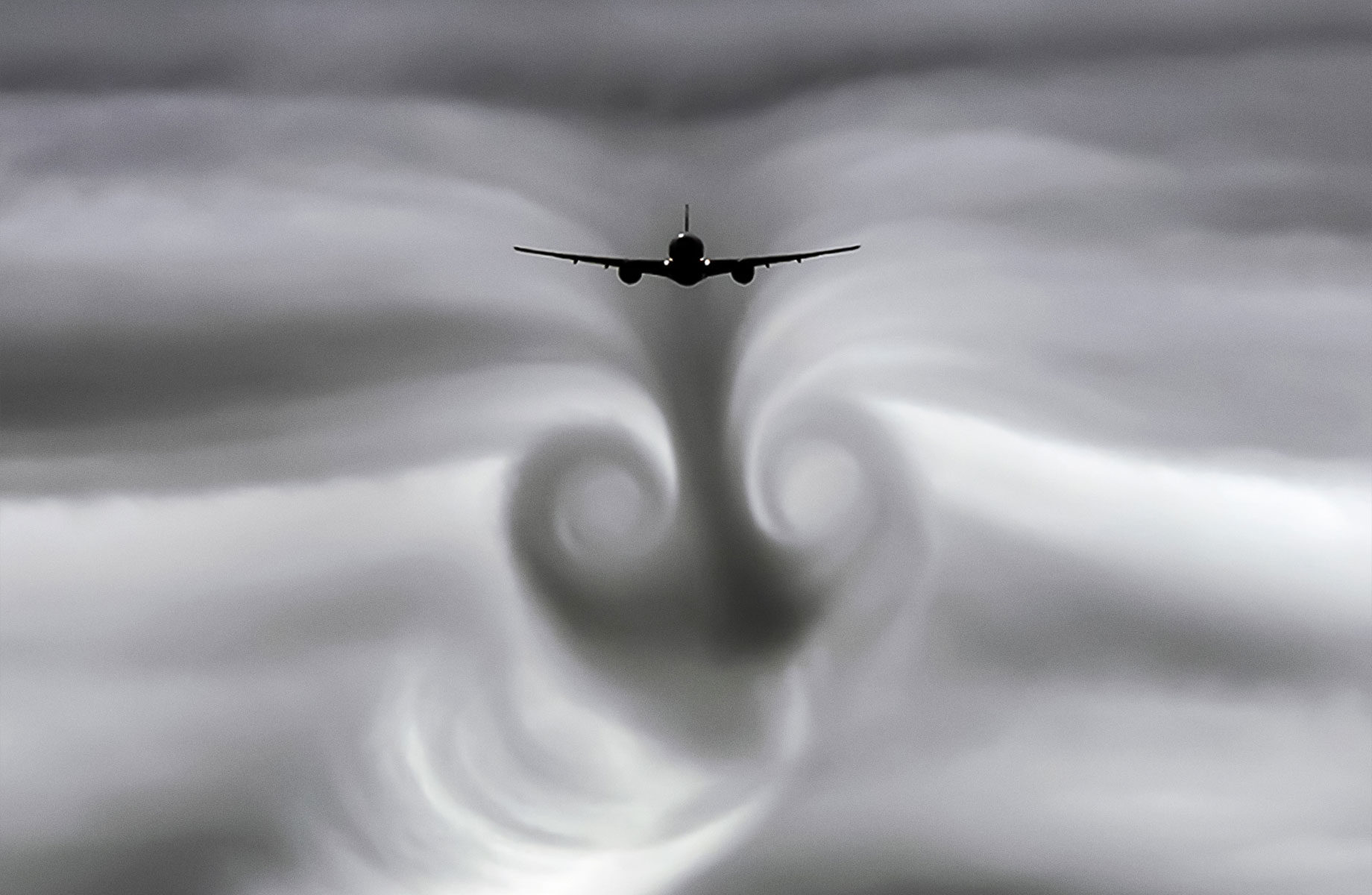
Wingtip edges create vortexes in the air.
But it’s turbulence that’s claiming a lot of the attention in Irvine’s lab these days. Having set up the perfect playground to create, combine and measure vortices and their helicity, Irvine and Matsuzawa four years ago started exploring new variations on the theme. They shot different numbers of vortex loops into the tank, at different frequencies, often getting them to combine in interesting ways. Sometimes they created patches of turbulence, but these tended to quickly fly apart again. But when they tried a cube-shaped hydrofoil that produced eight rings converging at a single spot, the resulting turbulence seemed to persist for a few moments. So they tried shooting eight rings quickly followed by another eight rings: The turbulence hung around even longer. Ultimately they discovered that the turbulent patch persisted as long as the barrage kept coming. The blob was born.
Turbulence has always been too complex to analyze, or even accurately measure. Matsuzawa calls it a “vorticity soup” — it takes all the complexities of individual vortices, and then mashes them together into a tangled, roiling mess of eddies and swirls with no distinct border, which span scales from the huge down to the submicroscopic, all continuously springing up, wildly morphing, merging, flying apart and disappearing moment to moment. Lathrop notes that physicists can’t even agree on a clear definition of turbulence, or if the turbulence that’s observed in, say, a pipe is the same phenomenon as the turbulence seen on aircraft wingtips. “We’re not sure what turbulence is,” he said. “It’s astonishing we’re still at this point, given the progress we’ve made in every other area of physics.”
One thing is clear: Turbulence is chaotic — meaning its behavior is hypersensitive to any change, including the speed, volume and direction of flow, the shapes of the surfaces around it, and much more. The result is that even an infinitesimal inaccuracy in any measurement of the turbulence is enough to throw off any analysis of how it might evolve. Not that this has mattered much, because there hasn’t been a good way to get any but the crudest measurements of the many rapidly shifting whorls and eddies in turbulence that manifest at scales differing by a factor of up to 10,000. Researchers have generally settled for repeatedly measuring flow speed at several points in the turbulence. To create turbulence in the lab, they had to run flowing water or air through a mesh or other semi-obstruction to disrupt the smooth flow — which meant the results were actually a combination of turbulent and non-turbulent activity that was hard to tease apart. “I give them credit for discovering anything at all about turbulence with those tools,” said Irvine.
A self-contained, persistent blob of turbulence constructed of well-characterized vortices offers a new world of possibilities for measurement and analysis. It is a simpler, steadier form of turbulence, uncorrupted by surrounding flows, surfaces and objects — a turbulence researcher’s plaything, posing for all the high-horsepower imaging that Irvine and Matsuzawa care to do. They can watch and tightly measure as the vortex loops merge and evolve into turbulence, analyze its steady state, subject it to various forces and tweaks to see how it responds, and then stop feeding it and study its decay.
But of all the insights Irvine hopes to wring from this bounteous observational platform, his primary target is a familiar one. “Turbulence is the hardest test of helicity conservation,” he said. “But because we’re building the turbulence one vortex at a time, we know how much helicity we’re putting into it. Then we can hammer away at the helicity to see what happens to it.”
As eager as he is to make progress with the blob, Irvine said he and Matsuzawa are probably at least a year away from a published paper, although Irvine has started to discuss it at conferences.
For now, at least, the blob seems very comfortable right where it is.
This article was reprinted on Spektrum.de.
